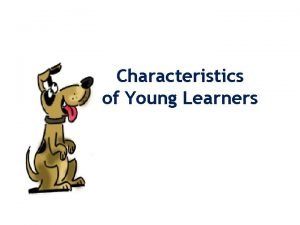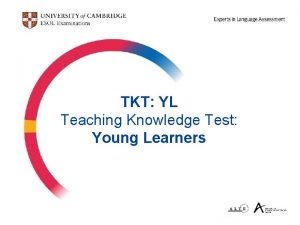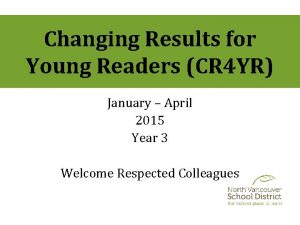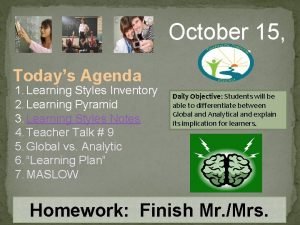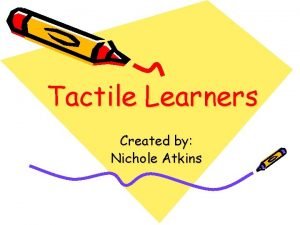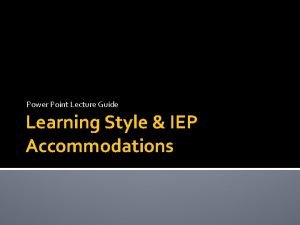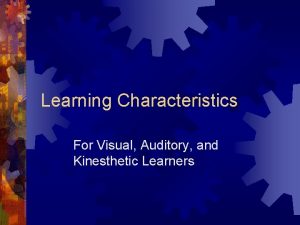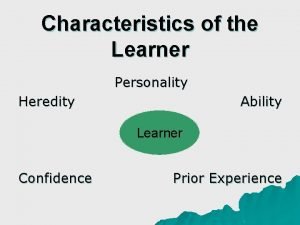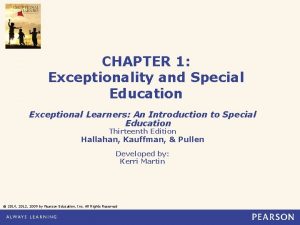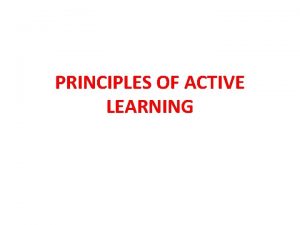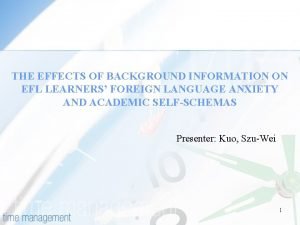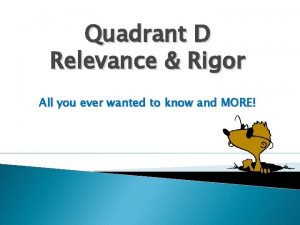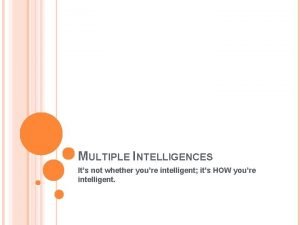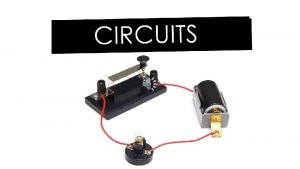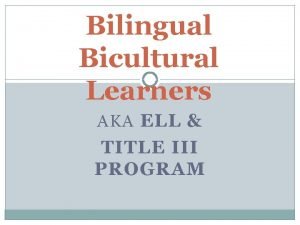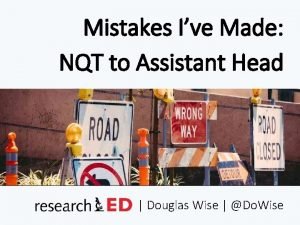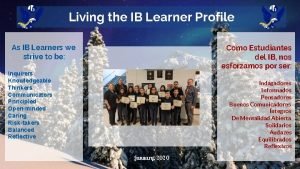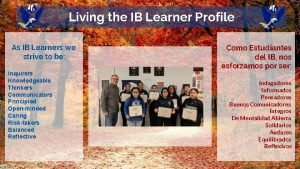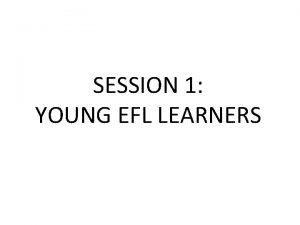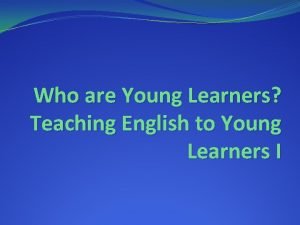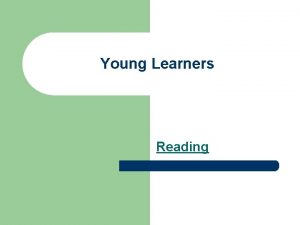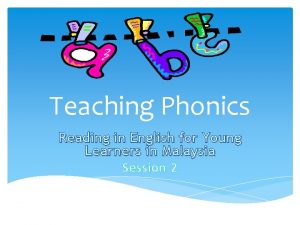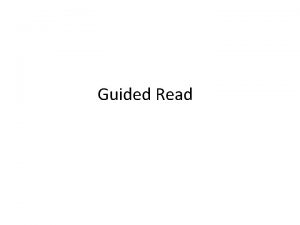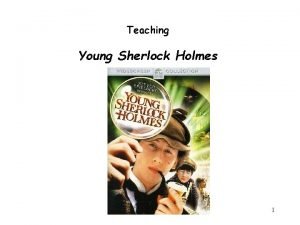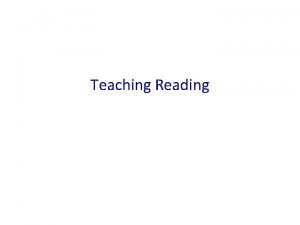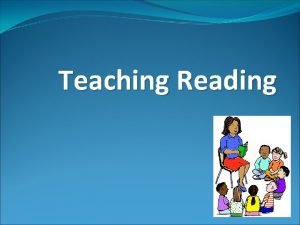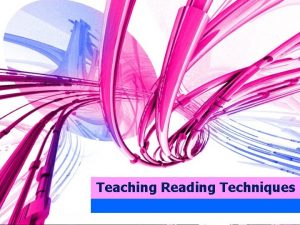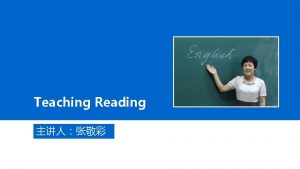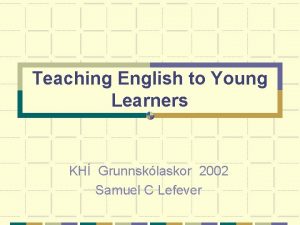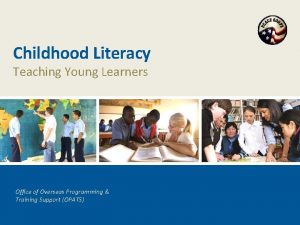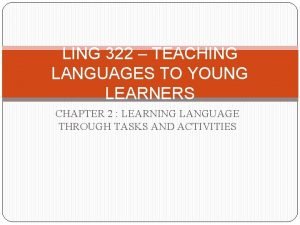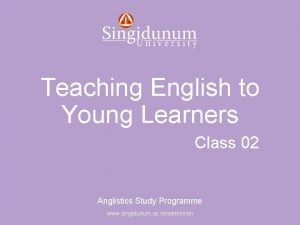Teaching Reading To Young Learners Group 5 A
































- Slides: 32

Teaching Reading To Young Learners Group 5 A 3/2015 The members : 1. Anisa Ramadhanty 2. Galih Setia Puspita 3. Nadia Sofia Fitri Dahlia

Reading 1 Reading is a great way to expand strengthen the language 2 In order to read, children must be able to decode and also comprehend what their read. 3 4

Background To the Teaching of Reading for pleasure Vision problems 01 03 R E A D 02 Reading for information 04 Configurations

Reading For Pleasure Using stories as a vital component. Reading For Information It can be as simple as reading a menu at a restaurant, reading a cookbook and so on.

Vision Problem 03 Holds a book close to the face Holds a book far away from the face D Squints, closes/covers one eye 02 D D 01 04 Loses place while reading 05 Complains of headaches after reading

Configuration HOUSE house Configuration is shape make up of the letters within a word.

The Development of Reading Skill 1 Phonics-based instruction 2 Literature-based approach 4

Phonics-Based Instruction The purpose of phonics instruction is to teach beginning reader that printed letters represent speech sounds heard in words. Heilman, 2002

Phonics Based Instruction “Teach students the basic English language phonics rules so that they can easily decode words”

Effective phonics instruction Sustains a brisk pace. 1 Engages children in activities that are relevant and puposeful. Differentiates lessons based on individual children’s needs. 5 2 Matches what is read with the concepts and strategies being taughts 4 3 6 Includes writing as significant component. Engages children in decision making and hands-on activities.

Literature Based Approach Harp&Brewer (2005), Defined literature based approach to reading instruction is teaching children to read using pieces of literature, both fiction and nonfiction. Proponents of literature based instruction usually focus on the importance of using authentic literature. Using authentic literature can open doors for students by introducing them to different cultures, social structures and story lines. Literature based approach is designed to help children develop an appreciation and enjoyment of literature while at the same time developing literacy skills.

Classroom Techniques and Activities 1. Phonics One of the easiest ways to begin phonics instruction is by introducing sounds and letters that are associated with specific noun. 2. Predictable Stories and pattern books. Predictable story books, also called pattern books, contain illustrations that help to clarify or support the word, sentence, or pattern that is repeated in the text (Optiz, 1995) 3. Sight Words Sight words are high-frequency words children can recognize on sight without having to decode the letters. e. g. : the, all, an and i (sight words). • Names • Print-Rich Environment

Learning Centers Learning centers are stations or places within a classroom where children can work alone, in pairs or in a small groups.

Learning Experience Approach 01 LEA is whole language approach that promote reading and writing through the use of personal/ actual experience and oral language as the main source of content for the reading lessons 02 LEA will typically provide an activity, or an experience, so that every student has something from which to draw 03 LEA teachers use a shared experience-often involving photographs/images of that experience – as a prompt to collectively write a text with the learners. This text often a series of photographs/images with captions becomes a text that the group reads-rereads, revises and extends.

Steps of LEA : nt g 01 ivin g s urn ce t e tak perien s t den of ex u t S tion a t c di 03 02 er ch Tea es writ b ts n ude t s o ck t a b ory word t s the each s d ea tracks r r che and a e T 04 ex hat w y actl aid is s ude t s y nts e d Stu rn tu take 05 gt n i t i rec tor s e h y . rips t s into t story t u is c struc e c n on e c t e n r h se must c a E nts e d u St


Benefit of LEA To develop and reinforce reading and writing using personal experiences and student’s own repertoire of language To help NES, ESL, EFL children develop beginning literacy skills

OWN WORDS Children’s own words to help young learner acquire English literacy skills.

Steps of Own Words : 01 02 03 04 The teacher ask them what words they would like to learn The teacher would write down their words in English on small cards The teacher ask children to come up with their own words related to the topics they are currently studying or words they would just like to know. These words can be written on small index cards or in the students note-book.


Questioning Techniques 98% The judicious use of questions is very important. Reading lesson, questions should be used to check comprehension and to help children think about what they are reading.

Before children read, you should ask questions to pique their interest. 1 Make sure that the number and type of questions you ask doesn’t detract from the enjoyment of reading. The questions should generate interest and enthusiasm for what is being read. 3 2 The thing should consider if we make question : Try to ask questions that help children become involved with the text 4

Comprehension Strategies Context Clues and print conventiom when strong readers come to an unfamiliar word. They can use context clues to help them determine the meaning of the unknown word. Graphic Organizer Graphic organizers are tools to help learners visually organize the information that they have read or will read.

Context Clues And Print Convention Some types of context clues : I Inference D Definition E Example A Anatonym S Synonym

Graphic Organizer a. KWL Chart What I Know What I Want to know What I Learned


Graphic Organizer b. Ven Diagram Cow Gives milk Both Farm Animal Have 4 Leg Horse Ride Mane


Context Clues And Print Convention c. Semantic Maps Baby bear Young boy bear Very sad Goldillocks Blonde Girls Stubborn Bad Story Pappa Bear Grown up Man bear Good Father Angry Mama Bear Grown up Woman bear Good Mother Angry


Reading In Classroom ü When you begin any reading lesson help children use context clues to determine meaning ü Choose the best coursebook , be sure to direct children to look for environmental print. ü Choose the best coursebook in text for information ü Choose

Conslusion In this chapter, decoding and comprehension were presented as they relate to reading and reading instruction. The two main purposes of reading : reading for pleasure and reading for information. The use of authentic materials including environmental print as well as material which intended for ESL and EFL learner also discussed. Thank You
 Teaching grammar to young learners
Teaching grammar to young learners Teaching young learners english
Teaching young learners english Characteristics of attention
Characteristics of attention Tkt: yl resources
Tkt: yl resources Changing results for young learners
Changing results for young learners The purpose of remedial teaching is to
The purpose of remedial teaching is to Reading strategies for english language learners
Reading strategies for english language learners While reading activities
While reading activities Comparison between micro teaching and traditional teaching
Comparison between micro teaching and traditional teaching Global vs analytical learners
Global vs analytical learners Heather nichole atkins
Heather nichole atkins Global vs analytical learners
Global vs analytical learners Auditory learning characteristics
Auditory learning characteristics Eager leaner
Eager leaner Kinesthetic learning
Kinesthetic learning When is cognitivism beneficial for learners
When is cognitivism beneficial for learners Visual iconic learners
Visual iconic learners Code of ethics for professional teachers
Code of ethics for professional teachers Inheritance characteristics
Inheritance characteristics Exceptional learners: an introduction to special education
Exceptional learners: an introduction to special education Assistive technology for english language learners
Assistive technology for english language learners Active learners definition
Active learners definition Questioning and discussion techniques
Questioning and discussion techniques Background information for learners
Background information for learners Quadrant d
Quadrant d Gifted and talented learners in the philippines
Gifted and talented learners in the philippines What famous person has naturalistic intelligence
What famous person has naturalistic intelligence Learners will be able to
Learners will be able to English language learners
English language learners Graham nuttall the hidden lives of learners
Graham nuttall the hidden lives of learners Learner profile inquirer
Learner profile inquirer Ib learners profile
Ib learners profile Equal protection for english language learners
Equal protection for english language learners


